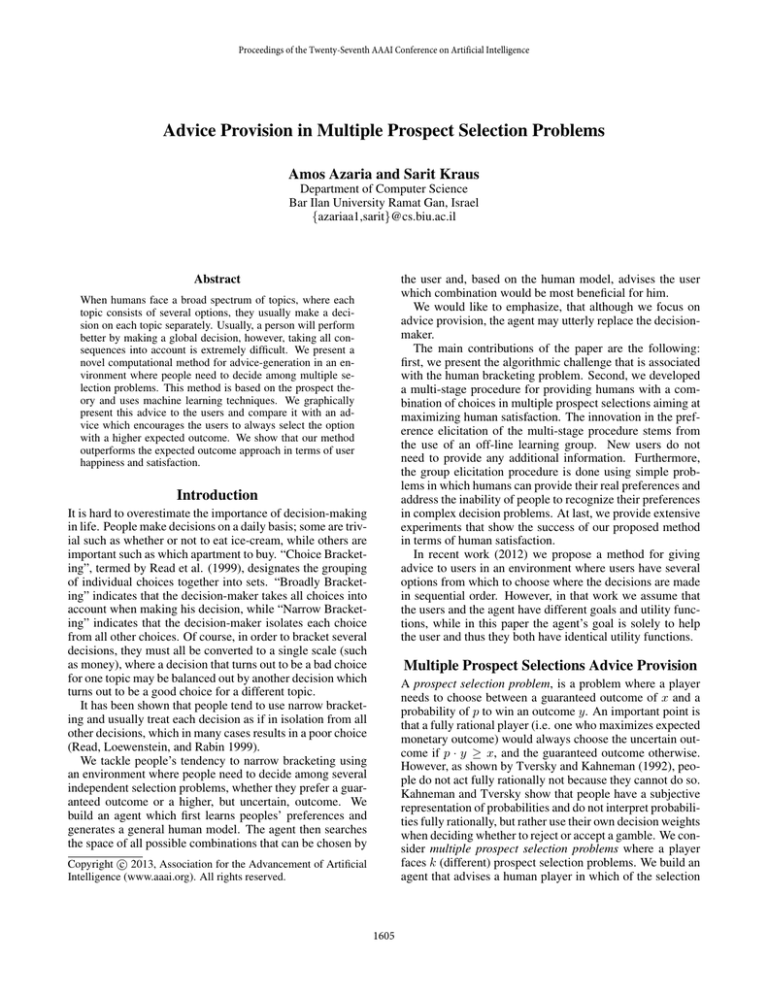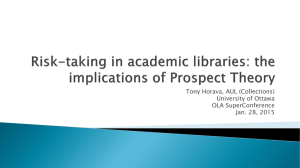
Proceedings of the Twenty-Seventh AAAI Conference on Artificial Intelligence
Advice Provision in Multiple Prospect Selection Problems
Amos Azaria and Sarit Kraus
Department of Computer Science
Bar Ilan University Ramat Gan, Israel
{azariaa1,sarit}@cs.biu.ac.il
Abstract
the user and, based on the human model, advises the user
which combination would be most beneficial for him.
We would like to emphasize, that although we focus on
advice provision, the agent may utterly replace the decisionmaker.
The main contributions of the paper are the following:
first, we present the algorithmic challenge that is associated
with the human bracketing problem. Second, we developed
a multi-stage procedure for providing humans with a combination of choices in multiple prospect selections aiming at
maximizing human satisfaction. The innovation in the preference elicitation of the multi-stage procedure stems from
the use of an off-line learning group. New users do not
need to provide any additional information. Furthermore,
the group elicitation procedure is done using simple problems in which humans can provide their real preferences and
address the inability of people to recognize their preferences
in complex decision problems. At last, we provide extensive
experiments that show the success of our proposed method
in terms of human satisfaction.
In recent work (2012) we propose a method for giving
advice to users in an environment where users have several
options from which to choose where the decisions are made
in sequential order. However, in that work we assume that
the users and the agent have different goals and utility functions, while in this paper the agent’s goal is solely to help
the user and thus they both have identical utility functions.
When humans face a broad spectrum of topics, where each
topic consists of several options, they usually make a decision on each topic separately. Usually, a person will perform
better by making a global decision, however, taking all consequences into account is extremely difficult. We present a
novel computational method for advice-generation in an environment where people need to decide among multiple selection problems. This method is based on the prospect theory and uses machine learning techniques. We graphically
present this advice to the users and compare it with an advice which encourages the users to always select the option
with a higher expected outcome. We show that our method
outperforms the expected outcome approach in terms of user
happiness and satisfaction.
Introduction
It is hard to overestimate the importance of decision-making
in life. People make decisions on a daily basis; some are trivial such as whether or not to eat ice-cream, while others are
important such as which apartment to buy. “Choice Bracketing”, termed by Read et al. (1999), designates the grouping
of individual choices together into sets. “Broadly Bracketing” indicates that the decision-maker takes all choices into
account when making his decision, while “Narrow Bracketing” indicates that the decision-maker isolates each choice
from all other choices. Of course, in order to bracket several
decisions, they must all be converted to a single scale (such
as money), where a decision that turns out to be a bad choice
for one topic may be balanced out by another decision which
turns out to be a good choice for a different topic.
It has been shown that people tend to use narrow bracketing and usually treat each decision as if in isolation from all
other decisions, which in many cases results in a poor choice
(Read, Loewenstein, and Rabin 1999).
We tackle people’s tendency to narrow bracketing using
an environment where people need to decide among several
independent selection problems, whether they prefer a guaranteed outcome or a higher, but uncertain, outcome. We
build an agent which first learns peoples’ preferences and
generates a general human model. The agent then searches
the space of all possible combinations that can be chosen by
Multiple Prospect Selections Advice Provision
A prospect selection problem, is a problem where a player
needs to choose between a guaranteed outcome of x and a
probability of p to win an outcome y. An important point is
that a fully rational player (i.e. one who maximizes expected
monetary outcome) would always choose the uncertain outcome if p · y ≥ x, and the guaranteed outcome otherwise.
However, as shown by Tversky and Kahneman (1992), people do not act fully rationally not because they cannot do so.
Kahneman and Tversky show that people have a subjective
representation of probabilities and do not interpret probabilities fully rationally, but rather use their own decision weights
when deciding whether to reject or accept a gamble. We consider multiple prospect selection problems where a player
faces k (different) prospect selection problems. We build an
agent that advises a human player in which of the selection
c 2013, Association for the Advancement of Artificial
Copyright Intelligence (www.aaai.org). All rights reserved.
1605
problems to choose the guaranteed outcome and in which
to choose the prospect. We measure the performance of the
agent in terms of human satisfaction.
We now present the prospect Selection problem Advice
provider for Multiple Problems agent (SAMP). To build this
agent we first use machine learning to elicit decision weights
from given data. Based on these decision weights we build a
general human model that can calculate the utility in human
eyes for any combination of choices in a multiple prospect
selection problem. Upon demand, SAMP searches for the
best combination using this model and presents it to the user.
The first step in building SAMP, is eliciting human decision weights. We collect data from subjects who were
asked to choose between a guaranteed outcome and a simple prospect. Note that this is a very simple choice and we
therefore assume that humans can provide their real preferences. Using the data we build a logistic regression classifier
to elicit the decision weights.
The main challenge which remains is to assess the value
of multiple (k) prospects. If we were simply to sum the
value of all prospects individually, we would fail by using the exact concept which we are trying to overcome,
i.e. narrow bracketing. The first step in assessing the
value of multiple prospects is calculating the final probability for each of the possible outcomes.
Pn Once we obtain
the probabilities p~ = p1 , p2 . . . pn ( i=1 pi = 1) and outcomes ~y = y 1 , y 2 . . . y n (y 1 < . . . < y n ), based upon
the Cumulative Prospect Theory (Tversky and Kahneman
1992),
we
value
p, ~y ) =
iuser by: u(~
Pn
Passessj the
P for the
i
j
d
p
y
−
d
p
y
.
Given
a
Multiple
i=1
j≥i
j>i
Prospect Selection Problem, each combination of choices
yields different vectors p~ and ~y and therefore using the
model above, each combination of choices yields a different user value (u(~
p, ~y )). SAMP searches for a combination
of choices which maximizes this value. We compare the performance of SAMP to the performance of a rational agent
which assumes human full rationality (i.e. assumes that people want to maximize their expected monetary value). Performance is measured in terms of human satisfaction.
Figure 1: A visualization of the agent’s advice
Figure 2: Comparison between user satisfaction levels
among subjects who received SAMP’s advice and those who
received the fully rational agent’s advice
terpretation of the pie chart was explained to the subjects,
and their comments indicated that they clearly understood
this interpretation. The subjects were asked the following
three questions: 1. Are you happy with the final result? 2.
Are you happy with the decisions you made? 3. How good
was the advice given to you by the system? The subjects
answered these questions on a 1 to 5 scale.
Figure 2 presents the final satisfaction levels for users who
received SAMP’s advice and users who received the fully rational advice. The higher the satisfaction level the better the
result. As can be seen in the figure, in all three questions
SAMP outperformed the rational agent. ANOVA test indicates that these results differ significantly (p < 0.05).
Experimental Design
We recruited 52 participants for SAMP’s learning phase and
202 participants for evaluating both SAMP and the fully rational agent. In the evaluation phase, each subject received
a single advice, either from SAMP or from the fully rational agent. In the learning phase the subjects did not receive
any advice. Each subject participated only once. We set
k = 5, i.e. the subjects had to make their choice regarding
five prospect selection problems. Prior to receiving the actual advice, the subjects were told that the advice is provided
by a third party agent which is trying to help them. The subjects were shown the consequences of following the advice
using a pie chart, which indicated the actual probability of
winning each possible outcome.
Figure 1 presents an example for a visualization of the
agent’s advice. In this example, if the user follows the exact advice given by the agent, he is guaranteed a win of at
least 8 cents, however, he might win upto 89 cents. The in-
References
Azaria, A.; Rabinovich, Z.; Kraus, S.; Goldman, C. V.; and
Gal, Y. 2012. Strategic advice provision in repeated humanagent interactions. In AAAI.
Read, D.; Loewenstein, G.; and Rabin, M. 1999. Choice
bracketing. Journal of Risk and Uncertainty 19(1):171–197.
Tversky, A., and Kahneman, D. 1992. Advances in prospect
theory: Cumulative representation of uncertainty. Journal of
Risk and Uncertainty 5(4):297–323.
1606




